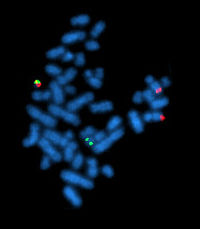
Photo from wikipedia
Tyrosine kinase inhibitors (TKIs) have profoundly improved the clinical outcome for patients with chronic myeloid leukemia (CML), but their overall survival is still subnormal and the treatment is associated with… Click to show full abstract
Tyrosine kinase inhibitors (TKIs) have profoundly improved the clinical outcome for patients with chronic myeloid leukemia (CML), but their overall survival is still subnormal and the treatment is associated with adverse events. In a large cohort‐study, we assessed the morbidity in 1328 Swedish CML chronic phase patients diagnosed 2002–2017 and treated with TKIs, as compared to that in carefully matched control individuals. Several Swedish patient registers with near‐complete nationwide coverage were utilized for data acquisition. Median follow‐up was 6 (IQR, 3–10) years with a total follow‐up of 8510 person‐years for the full cohort. Among 670 analyzed disease categories, the patient cohort showed a significantly increased risk in 142 while, strikingly, no category was more common in controls. Increased incidence rate ratios/IRR (95% CI) for more severe events among patients included acute myocardial infarction (AMI) 2.0 (1.5–2.6), heart failure 2.6 (2.2–3.2), pneumonia 2.8 (2.3–3.5), and unspecified sepsis 3.5 (2.6–4.7). When comparing patients on 2nd generation TKIs vs. imatinib in a within‐cohort analysis, nilotinib generated elevated IRRs for AMI (2.9; 1.5–5.6) and chronic ischemic heart disease (2.2; 1.2–3.9), dasatinib for pleural effusion (11.6; 7.6–17.7) and infectious complications, for example, acute upper respiratory infections (3.0; 1.4–6.0). Our extensive real‐world data reveal significant risk increases of severe morbidity in TKI‐treated CML patients, as compared to matched controls, particularly for 2nd generation TKIs. Whether this increased morbidity may also translate into increased mortality, thus preventing CML patients to achieve a normalized overall survival, needs to be further explored.
Journal Title: American Journal of Hematology
Year Published: 2022
Link to full text (if available)
Share on Social Media: Sign Up to like & get
recommendations!